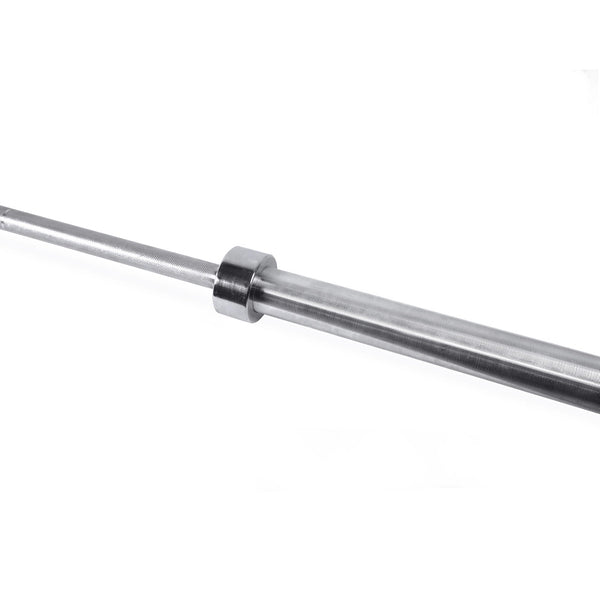Your Cart is Empty
October 13, 2023 4 min read
When it comes to fitness, barbells are an essential piece of equipment. They are versatile and can be used for a variety of exercises, including squats, deadlifts, presses, and curls. Barbells come in a variety of shapes, sizes, and weights, so it’s important to choose the right type for your individual needs.
Shop The Collection: BarbellsWhether you’re a beginner looking for a basic barbell or an experienced lifter looking for something more advanced, there are plenty of options available. In this article, we’ll discuss the different types of barbells and how they can help you achieve your fitness goals.
 Shop The Gear: CAP Barbell Olympic Chrome Bar, 7-ft, $89.99 CAD
Shop The Gear: CAP Barbell Olympic Chrome Bar, 7-ft, $89.99 CAD
The most common type of barbell is the standard barbell. This is the traditional barbell that is found in most gyms and is typically made from steel. It is usually 7 feet long and has a “sleeve” at each end, which is where you can load plates onto the bar. Standard barbells are available in a variety of weights, ranging from 10 to 55 pounds.
Shop The Collection: Weight PlatesStandard barbells are great for the majority of exercises, such as squats, deadlifts, presses, rows, and curls. They are also often used in Olympic weightlifting exercises, such as the snatch and the clean and jerk. The standard barbell is a great all-around choice for both beginner and experienced lifters.
 Shop The Gear: CAP Barbell Olympic Solid Bar, 5-ft, from $69.99 CAD
Shop The Gear: CAP Barbell Olympic Solid Bar, 5-ft, from $69.99 CAD
Olympic barbells are similar to standard barbells, but they are generally longer and thicker. They are usually 7.2 feet long and have a diameter of two inches. Olympic barbells usually weigh 45 pounds and are designed for Olympic weightlifting exercises. They are also commonly used for powerlifting exercises such as the squat and the deadlift.
Olympic barbells are made with a higher tensile strength than standard barbells, so they are less likely to bend or warp. This makes them ideal for heavy lifts and intense workouts. They also have rotating sleeves, which allow the plates to move freely while lifting. This reduces stress on the wrists and elbows.
Training barbells, also known as technique bars, are lighter barbells that are designed for beginners and those who are just starting out with weight training. They are typically shorter than standard barbells and are much lighter in weight. Training barbells usually range from 5 to 15 pounds and are made from either steel or aluminum.
These barbells allow beginners to practice proper form and technique without having to lift too much weight. They also reduce the risk of injury since the lighter weight puts less strain on the muscles. If you’re just starting out with weight training, a training barbell is a great option.
Collar barbells are a type of barbell that has collars on the ends of the bar, which prevent the plates from slipping off. They are great for performing exercises such as deadlifts, overhead presses, and bent-over rows. They are also useful for keeping the weights secure while performing exercises such as curls and tricep extensions.
Collar barbells are usually only available in standard sizes, such as 7 feet long and 45 pounds. They are typically made from steel and come with collars that are adjustable and easy to use. Collar barbells are a good choice if you’re looking for a barbell that will keep your weights in place while you exercise.
In addition to the standard types of barbells, there are also specialty barbells available. These include safety bars, trap bars, Swiss bars, and curl bars. Each type of barbell is designed for a specific purpose and can help you achieve different results.
Safety bars, also known as squat bars, are designed to reduce the risk of injury when performing squats. They are usually shorter than standard barbells and have a curved design that allows the user to keep their back in a neutral position. This helps reduce the risk of back injuries while squatting.
Trap bars, also known as hex bars, are designed for deadlifts and other pulling exercises. They are shaped like a hexagon and allow the user to stand inside the frame rather than behind the bar. This helps reduce the strain on the lower back, making them safer than traditional deadlifts.
Swiss bars are designed for pressing exercises, such as bench presses and overhead presses. They are made from steel and have angled handles, which allow the user to perform exercises with a neutral grip. This helps reduce the strain on the wrists and shoulders.
Curl bars are designed for bicep curls and other arm exercises. They are typically shorter than standard barbells and have angled handles that provide a more comfortable grip. Curl bars are also much lighter than standard barbells, making them easier to control.
When it comes to barbells, there are many types to choose from. Standard barbells are great for the majority of exercises, while Olympic barbells are designed for heavier lifts. Training barbells are ideal for beginners, and collar barbells are great for keeping the weights in place. There are also specialty barbells available, such as safety bars, trap bars, Swiss bars, and curl bars.
No matter what your fitness goals are, there is a type of barbell that can help you achieve them. Whether you’re a beginner or an experienced lifter, having the right barbell is essential for getting the most out of your workouts.
Shipping Protection gives you peace of mind while saving you time and money.
Shipping Protection provides coverage for eligible orders that are lost or damaged in transit, or stolen after delivery has been confirmed by the carrier. MAGMA Fitness, through its partners, administers the protection program and may receive compensation for these services. Coverage is subject to the terms, conditions, and exclusions outlined in our Shipping Protection Terms & Conditions.